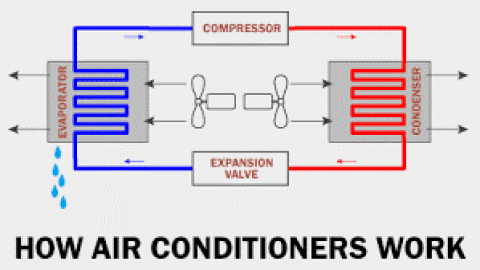Install AC
Central air conditioners circulate cool air through a system of supply and return ducts. Supply ducts and registers (i.e., openings in the walls, floors, or ceilings covered by grills) carry cooled air from the air conditioner to the home. This cooled air becomes warmer as it circulates through the home; then it flows back to the central air conditioner through return ducts and registers. To learn how central air conditioners compare to other cooling systems, check out our Energy Saver 101 Infographic: Home Cooling.
Air conditioners dehumidify the air to improve comfort. However, in extremely humid climates, when outdoor temperatures are moderate, or in cases where the air conditioner is oversized, the air may not reach a low enough humidity to achieve a comfortable level. In those instances, homeowners may reduce the thermostat setting or use a dehumidifier. But in both cases this will increase energy use, both for the dehumidifier itself and because the air conditioner will require more energy to cool the house.
If you have a central air system in your home, set the fan to the “auto” mode. In other words, don’t use the system’s central fan to provide air circulation — use circulating fans in individual rooms. Schedule now FREE ESTIMATE
Types of Central Air Conditioners (Install AC)
A central air conditioner is either a split-system unit or a packaged unit.
In a split-system central air conditioner, an outdoor cabinet contains the outdoor heat exchanger, fan, and compressor, and an indoor cabinet contains the indoor heat exchanger and blower. In many split-system air conditioners, the indoor cabinet may contain the a furnace or the indoor heat exchanger of a heat pump. If your home already has a furnace but no air conditioner, a split-system may be the most economical central air conditioner to install.
In a packaged central air conditioner, the heat exchangers, compressor, fan, and blower are all located in one cabinet, which usually is placed on a roof or on a concrete slab next to the house’s foundation. This type of air conditioner also is used in small commercial buildings. The supply and return ducts come from indoors through the home’s exterior wall or roof to connect with the packaged air conditioner. Packaged air conditioners often include electric heating coils or a natural gas furnace. This combination of air conditioner and central heater eliminates the need for a separate furnace.Schedule now FREE ESTIMATE
Installation and Location of Air Conditioners (Install AC)
If your air conditioner is installed correctly, or if major installation problems are found and fixed, it should perform efficiently for years with only minor routine maintenance. However, many air conditioners are not installed correctly. As an unfortunate result, modern energy-efficient air conditioners can perform almost as poorly as older inefficient models.Schedule now FREE ESTIMATE
When installing a new central air conditioning system, be sure that your contractor: Schedule now FREE ESTIMATE
- Allows adequate indoor space for the installation, maintenance, and repair of the new system
- Uses a duct-sizing methodology such as the Air Conditioning Contractors of America (ACCA) Manual D
- Ensures there are enough supply registers to deliver cool air and enough return air registers to carry warm house air back to the air conditioner
- Installs duct work within the conditioned space, not in the attic, wherever possible
- Seals all ducts with duct mastic and heavily insulates ducts
- Locates the condensing unit where its noise will not keep you or your neighbors awake at night, if possible
- Locates the condensing unit where no nearby objects will block airflow to it
- Verifies that the newly installed air conditioner has the exact refrigerant charge and airflow rate specified by the manufacturer
- Locates the thermostat away from heat sources, such as windows or supply registers.
- Schedule now FREE ESTIMATE
Choosing or Upgrading Your Central Air Conditioner (Instaal AC)
Central air conditioners are more efficient than room air conditioners. In addition, they are out of the way, quiet, and convenient to operate. To save energy and money, you should try to buy an energy-efficient air conditioner and reduce your central air conditioner’s energy use. In an average size home, air conditioning consumes more than 2,000 kilowatt-hours of electricity per year, causing power plants to emit about 3,500 pounds of carbon dioxide and 31 pounds of sulfur dioxide.
If you are considering adding central air conditioning to your home, the deciding factor may be the need for ductwork.
The most efficient air conditioners use 30% to 50% less energy to produce the same amount of cooling as air conditioners made in the mid 1970s. Even if your air conditioner is only 10 years old, you may save 20% to 40% of your cooling energy costs by replacing it with a newer, more efficient model.
Proper sizing and installation are key elements in determining air conditioner efficiency. Too large a unit will not adequately remove humidity. Too small a unit will not be able to attain a comfortable temperature on the hottest days. Improper unit location, lack of insulation, and improper duct installation can greatly diminish efficiency. Schedule now FREE ESTIMATE
When buying an air conditioner, look for a model with a high efficiency. Central air conditioners are rated according to their seasonal energy efficiency ratio (SEER). SEER indicates the relative amount of energy needed to provide a specific cooling output. Many newer systems have SEER ratings as high as 26.
If your air conditioner is old, consider buying an energy-efficient model. Look for the ENERGY STAR® and EnergyGuide labels — qualified central units are about 15% more efficient than standard models. New residential central air conditioner standards went into effect on January 1, 2015; see the efficiency standards for central air conditioners for details, and consider purchasing a system with a higher SEER than the minimum for greater savings.
The standards do not require you to change your existing central air conditioning units, and replacement parts and services should still be available for your home’s systems. The “lifespan” of a central air conditioner is about 15 to 20 years. Manufacturers typically continue to support existing equipment by making replacement parts available and honoring maintenance contracts after the new standard goes into effect. Schedule now FREE ESTIMATE
Other features to look for when buying an air conditioner include:
- A variable speed air conditioning system
- A unit that operates quietly
- A filter check light to remind you to check the filter after a predetermined number of operating hours
- An automatic-delay fan switch to turn off the fan a few minutes after the compressor turns off.
- Schedule now FREE ESTIMATE
Consumer Central Air Conditioners and Heat Pumps
Central air conditioners and heat pumps include split system central air conditioners and heat pumps, single package central air conditioners and heat pumps, small-duct high-velocity products, and space constrained products. They are installed as part of an indoor climate control system. They may or may not use ducts to distribute cooled or dehumidified air to more than one room. Some ductless air conditioners and heat pumps are configured as split systems and are commonly referred to as mini-splits or multi-splits. Due to their configuration as split systems, mini- and multi-splits are also defined as central air conditioners and heat pumps rather than room air conditioners. Manufacturers have been required to comply with the U.S. Department of Energy (DOE) energy conservation standards for residential central air conditioners and heat pumps since 1992.
Air conditioners employ the same operating principles and basic components as your home refrigerator. Refrigerators use energy (usually electricity) to transfer heat from the cool interior of the refrigerator to the relatively warm surroundings of your home; likewise, an air conditioner uses energy to transfer heat from the interior of your home to the relatively warm outside environment.Schedule now FREE ESTIMATE
An air conditioner cools your home with a cold indoor coil called the evaporator. The condenser, a hot outdoor coil, releases the collected heat outside. The evaporator and condenser coils are serpentine tubing surrounded by aluminum fins. This tubing is usually made of copper. Schedule now FREE ESTIMATE
A pump, called the compressor, moves a heat transfer fluid (or refrigerant) between the evaporator and the condenser. The pump forces the refrigerant through the circuit of tubing and fins in the coils.
The liquid refrigerant evaporates in the indoor evaporator coil, pulling heat out of indoor air and cooling your home. The hot refrigerant gas is pumped outdoors into the condenser where it reverts back to a liquid, giving up its heat to the outside air flowing over the condenser’s metal tubing and fins.
Throughout the second half of the 20th century, nearly all air conditioners used chlorofluorocarbons (CFCs) as their refrigerant, but because these chemicals are damaging to Earth’s ozone layer, CFC production stopped in the United States in 1995. Nearly all air conditioning systems now use halogenated chlorofluorocarbons (HCFCs) as a refrigerant. The latest HCFC, HCFC-22 (also called R-22), began to be phased out in 2010 and stopped entirely in 2020. However, HCFC-22 is expected to be available for many years as it is removed and reused from old systems that are taken out of service. As these refrigerants are phased out, ozone-safe hydrofluorocarbons (HFCs) are expected to dominate the market, as well as alternative refrigerants such as ammonia.










